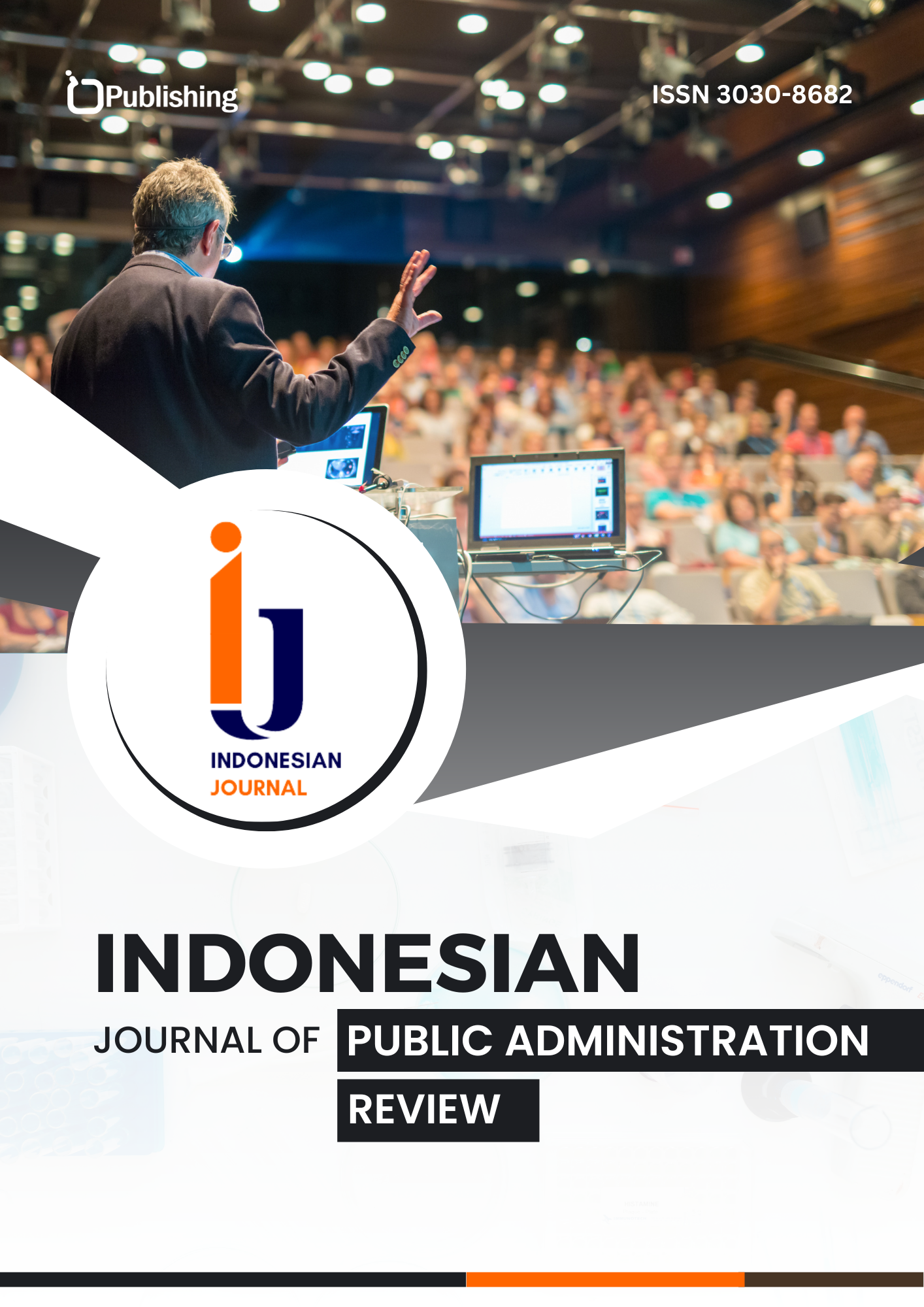Implementasi Problem Tree Analysis dalam Pengambilan Keputusan Program Kalimasada di Kecamatan Lakarsantri Kota Surabaya
DOI:
https://doi.org/10.47134/par.v1i2.2467Keywords:
Kalimasada, Pengambilan Keputusan, Problem Tree AnalysisAbstract
Administrasi kependudukan di Indonesia masih perlu adanya perbaikan agar dapat tercipta pelayanan publik yang prima. Kajian pustaka ini mempunyai tujuan untuk menjelaskan strategi problem Tree Analysis dalam pengambilan keputusan pada Program Kalimasada di Kecamatan lakarsantri Kota Surabaya. Metode yang digunakan adalah pendekatan deskriptif kualitatif dimana untuk menggali detail objek penelitian dengan dalam, sehingga kemudian dapat diperoleh pemahaman yang mendalam pula atas objek yang diteliti. Hasil utama dari strategi ini berupa diagram yang membahas mengenai fokus, akar, sebab, dan akibat dari permasalahan yang ada. Berdasarkan Tree Analysis yang telah dirancang dalam penelitian ini, penyebab dari permasalahan masyarakat yang kurang tertib administrasi kependudukan adalah karena kurangnya kesadaran masyarakat akan pentingnya administrasi kependudukan, masyarakat tidak bisa mengurus langsung di birokrasi, prosedur birokrasi yang berbelit-belit, dan rendahnya tingkat kepercayaan masyarakat pada birokrasi. Akar penyebab dari permasalahan yang ada yaitu karena faktor ekonomi, adanya program yang lebih penting, latar belakang pekerjaan yang beragam, birokrasi yang bersifat tradisional dan keinginan memenuhi kebutuhan hidup. Adanya informasi mengenai sebab dan akibat dari masyarakat yang kurang tertib administrasi kependudukan dapat membantu pemerintah dalam mengambil keputusan berupa Program Kalimasada.
References
Agustina, L. (2023). Dampak Pelatihan Terhadap Kinerja Pegawai di Dinas Kependudukan dan Pencatatan Sipil Kota Tanjungpinang. Universitas Maritim Raja Ali Haji.
Badida, P. (2019). Risk evaluation of oil and natural gas pipelines due to natural hazards using fuzzy fault tree analysis. Journal of Natural Gas Science and Engineering, 66, 284–292. https://doi.org/10.1016/j.jngse.2019.04.010 DOI: https://doi.org/10.1016/j.jngse.2019.04.010
Choubin, B. (2019). An ensemble prediction of flood susceptibility using multivariate discriminant analysis, classification and regression trees, and support vector machines. Science of the Total Environment, 651, 2087–2096. https://doi.org/10.1016/j.scitotenv.2018.10.064 DOI: https://doi.org/10.1016/j.scitotenv.2018.10.064
Cram, W. A. (2019). Seeing the forest and the trees: A meta-analysis of the antecedents to information security policy compliance. MIS Quarterly: Management Information Systems, 43(2), 525–554. https://doi.org/10.25300/MISQ/2019/15117 DOI: https://doi.org/10.25300/MISQ/2019/15117
Ebrahimi, M. (2019). Comprehensive analysis of machine learning models for prediction of sub-clinical mastitis: Deep Learning and Gradient-Boosted Trees outperform other models. Computers in Biology and Medicine, 114. https://doi.org/10.1016/j.compbiomed.2019.103456 DOI: https://doi.org/10.1016/j.compbiomed.2019.103456
Fathur, A. (2024). Masalah Pembiayaan Pendidikan di Indonesia: Kenaikan Biaya Pendidikan. Invention: Journal Research and Education Studies, 1–12. DOI: https://doi.org/10.51178/invention.v5i1.1648
Fernández, J. E. (2020). Water use indicators and economic analysis for on-farm irrigation decision: A case study of a super high density olive tree orchard. Agricultural Water Management, 237. https://doi.org/10.1016/j.agwat.2020.106074 DOI: https://doi.org/10.1016/j.agwat.2020.106074
Ferreira, M. P. (2019). Tree species classification in tropical forests using visible to shortwave infrared WorldView-3 images and texture analysis. ISPRS Journal of Photogrammetry and Remote Sensing, 149, 119–131. https://doi.org/10.1016/j.isprsjprs.2019.01.019 DOI: https://doi.org/10.1016/j.isprsjprs.2019.01.019
Fitri, V. (2019). Sentiment analysis of social media Twitter with case of Anti-LGBT campaign in Indonesia using Naïve Bayes, decision tree, and random forest algorithm. Procedia Computer Science, 161, 765–772. https://doi.org/10.1016/j.procs.2019.11.181 DOI: https://doi.org/10.1016/j.procs.2019.11.181
Guerrero, M. D. (2020). Canadian children’s and youth’s adherence to the 24-h movement guidelines during the COVID-19 pandemic: A decision tree analysis. Journal of Sport and Health Science, 9(4), 313–321. https://doi.org/10.1016/j.jshs.2020.06.005 DOI: https://doi.org/10.1016/j.jshs.2020.06.005
Ha, N. S. (2021). Crashworthiness analysis of bio-inspired fractal tree-like multi-cell circular tubes under axial crushing. Thin-Walled Structures, 169. https://doi.org/10.1016/j.tws.2021.108315 DOI: https://doi.org/10.1016/j.tws.2021.108315
Hew, K. F. (2020). What predicts student satisfaction with MOOCs: A gradient boosting trees supervised machine learning and sentiment analysis approach. Computers and Education, 145. https://doi.org/10.1016/j.compedu.2019.103724 DOI: https://doi.org/10.1016/j.compedu.2019.103724
Isti’anah, S. N. (2023). Efektivitas Program KALIMASADA Dalam Meningkatkan Kesadaran Masyarakat Akan Pentingnya Administrasi Kependudukan di Kelurahan Kendangsari. PUBLIKA: Jurnal Ilmu Administrasi Publik, 171–178. DOI: https://doi.org/10.25299/jiap.2023.13532
Kang, J. (2019). Fault Tree Analysis of floating offshore wind turbines. Renewable Energy, 133, 1455–1467. https://doi.org/10.1016/j.renene.2018.08.097 DOI: https://doi.org/10.1016/j.renene.2018.08.097
Khuzaimah. (2023). Peran Program Kalimasada Dalam Membentuk Habitus Sadar Administrasi Kependudukan Pada Masyarakat Kelurahan Jambangan. Seminar Nasional 2023.
Kuzu, A. C. (2019). Application of Fuzzy Fault Tree Analysis (FFTA) to maritime industry: A risk analysing of ship mooring operation. Ocean Engineering, 179, 128–134. https://doi.org/10.1016/j.oceaneng.2019.03.029 DOI: https://doi.org/10.1016/j.oceaneng.2019.03.029
Mahrani, S., & Hardjati, S. (2023). Optimization Of The Program Of Environmentally Conscious Areas Of Population Administration (KALIMASADA) In Pakal District Surabaya City. Journal of Governance and Administrative Reform, 137–157. DOI: https://doi.org/10.20473/jgar.v4i2.53366
Meza, J. K. S. (2019). Predictive analysis of urban waste generation for the city of Bogotá, Colombia, through the implementation of decision trees-based machine learning, support vector machines and artificial neural networks. Heliyon, 5(11). https://doi.org/10.1016/j.heliyon.2019.e02810 DOI: https://doi.org/10.1016/j.heliyon.2019.e02810
Purba, M. (2021). Faktor Internal dan Eksternal yang Memengaruhi Status Putus Sekolah di Provinsi DKI Jakarta Tahun 2021 (Internal and External Factors Affecting Drop Out Status in DKI Jakarta Province in 2021).
Puttick, M. N. (2019). MCMCtreeR: Functions to prepare MCMCtree analyses and visualize posterior ages on trees. Bioinformatics, 35(24), 5321–5322. https://doi.org/10.1093/bioinformatics/btz554 DOI: https://doi.org/10.1093/bioinformatics/btz554
Rahman, M. A. (2020). Traits of trees for cooling urban heat islands: A meta-analysis. Building and Environment, 170. https://doi.org/10.1016/j.buildenv.2019.106606 DOI: https://doi.org/10.1016/j.buildenv.2019.106606
Setya, P. A. (2022). Optimalisasi Kualitas Pelayanan Publik Dengan Program Kalimasada Melalui Aplikasi Klampid di Kelurahan Nginden Jangkungan. Community Development Journal: Jurnal Pengabdian Masyarakat, 112–117.
Sun, K. (2019). Aspect-level sentiment analysis via convolution over dependency tree. EMNLP-IJCNLP 2019 - 2019 Conference on Empirical Methods in Natural Language Processing and 9th International Joint Conference on Natural Language Processing, Proceedings of the Conference, 5679–5688. DOI: https://doi.org/10.18653/v1/D19-1569
Toraih, E. A. (2020). Association of cardiac biomarkers and comorbidities with increased mortality, severity, and cardiac injury in COVID-19 patients: A meta-regression and decision tree analysis. Journal of Medical Virology, 92(11), 2473–2488. https://doi.org/10.1002/jmv.26166 DOI: https://doi.org/10.1002/jmv.26166
Ung, S. (2019). Evaluation of human error contribution to oil tanker collision using fault tree analysis and modified fuzzy Bayesian Network based CREAM. Ocean Engineering, 179, 159–172. https://doi.org/10.1016/j.oceaneng.2019.03.031 DOI: https://doi.org/10.1016/j.oceaneng.2019.03.031
Wang, J. (2020). Tree-Structured Regional CNN-LSTM Model for Dimensional Sentiment Analysis. IEEE/ACM Transactions on Audio Speech and Language Processing, 28, 581–591. https://doi.org/10.1109/TASLP.2019.2959251 DOI: https://doi.org/10.1109/TASLP.2019.2959251
Wang, L. (2020). Multifeature analyses of vascular cambial cells reveal longevity mechanisms in old Ginkgo biloba trees. Proceedings of the National Academy of Sciences of the United States of America, 117(4), 2201–2210. https://doi.org/10.1073/pnas.1916548117 DOI: https://doi.org/10.1073/pnas.1916548117
Yazdi, M. (2020). Application of fuzzy fault tree analysis based on modified fuzzy AHP and fuzzy TOPSIS for fire and explosion in the process industry. International Journal of Occupational Safety and Ergonomics, 26(2), 319–335. https://doi.org/10.1080/10803548.2018.1454636 DOI: https://doi.org/10.1080/10803548.2018.1454636
Zhang, M. (2019). Use of HFACS and fault tree model for collision risk factors analysis of icebreaker assistance in ice-covered waters. Safety Science, 111, 128–143. https://doi.org/10.1016/j.ssci.2018.07.002 DOI: https://doi.org/10.1016/j.ssci.2018.07.002










